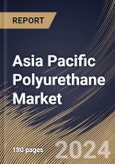Polyols-based polyurethane, a key segment in the polyurethane market, finds widespread applications across industries. Polyols, commonly derived from petrochemical or bio-based sources, serve as the building blocks for polyurethane production. Therefore, the Japan market consumed 3,148.5 kilo tonnes of polyurethane in 2022.
The China market dominated the Asia Pacific Polyurethane Market by Country in 2022, and would continue to be a dominant market till 2030; thereby, achieving a market value of $16,233.3 million by 2030. The Japan market is registering a CAGR of 3.7% during (2023 - 2030). Additionally, The India market would showcase a CAGR of 5.1% during (2023 - 2030).
The polyurethane applications are diverse and extensive, spanning various sectors due to the material’s versatile properties and adaptability. Polyurethane foam is widely used in construction as a building insulation material due to its excellent thermal performance.
Moreover, it helps reduce energy consumption by providing effective insulation against heat transfer, thus contributing to energy efficiency and sustainability. Polyurethane sealants and adhesives are utilized for bonding and sealing applications in construction, offering superior adhesion to a wide range of substrates and ensuring durability and weatherproofing.
As per the State Council of the People’s Republic of China, the electronics manufacturing industry of China maintained steady expansion during the first two months of 2022. From January to February, the added value of major electronics manufacturers rose 12.7 percent year-on-year, compared with the 7.5 percent growth seen in the overall industrial sector. As the electronics industry in China expands, there will likely be a higher demand for polyurethane materials used for encapsulation and potting of electronic components. Therefore, the expansion of the medical device sector and the growth of the electronics sector China is propelling the demand for polyurethane in the region.
Based on Raw Material, the market is segmented into Polyols, Toluene Di-isocyanate, Methylene Diphenyl Di-isocyanate, and Others. Based on Application, the market is segmented into Construction, Furniture & Interiors, Electronics & Appliances, Footwear, Automotive, Packaging, and Others. Based on Product, the market is segmented into Rigid Foam, Flexible Foam, Coatings, Adhesives & Sealants, Elastomers, and Others. Based on countries, the market is segmented into China, Japan, India, South Korea, Singapore, Malaysia, and Rest of Asia Pacific.
List of Key Companies Profiled
- ArcelorMittal S.A.
- thyssenkrupp AG
- BASF SE
- Covestro AG
- The Dow Chemical Company
- Huntsman Corporation
- Lanxess AG
- Mitsui Chemicals, Inc.
- Tosoh Corporation
- Eastman Chemical Company
Market Report Segmentation
By Raw Material (Volume, Kilo Tonnes, USD Billion,2019-2030)- Polyols
- Toluene Di-isocyanate
- Methylene Diphenyl Di-isocyanate
- Others
- Construction
- Furniture & Interiors
- Electronics & Appliances
- Footwear
- Automotive
- Packaging
- Others
- Rigid Foam
- Flexible Foam
- Coatings
- Adhesives & Sealants
- Elastomers
- Others
- China
- Japan
- India
- South Korea
- Singapore
- Malaysia
- Rest of Asia Pacific
Table of Contents
Companies Mentioned
- ArcelorMittal S.A.
- thyssenkrupp AG
- BASF SE
- Covestro AG
- The Dow Chemical Company
- Huntsman Corporation
- Lanxess AG
- Mitsui Chemicals, Inc.
- Tosoh Corporation
- Eastman Chemical Company
Methodology

LOADING...









